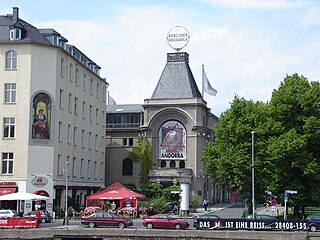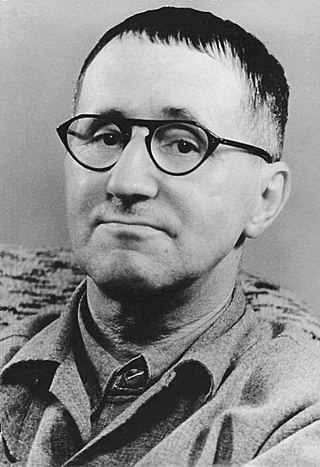Related Research Articles

Life of Galileo, also known as Galileo, is a play by the 20th century German dramatist Bertolt Brecht and collaborator Margarete Steffin with incidental music by Hanns Eisler. The play was written in 1938 and received its first theatrical production at the Zurich Schauspielhaus, opening on the 9th of September 1943. This production was directed by Leonard Steckel, with set-design by Teo Otto. The cast included Steckel himself, Karl Paryla and Wolfgang Langhoff.

Mother Courage and Her Children is a play written in 1939 by the German dramatist and poet Bertolt Brecht (1898–1956), with significant contributions from Margarete Steffin. Four theatrical productions were produced in Switzerland and Germany from 1941 to 1952, the last three supervised and/or directed by Brecht, who had returned to East Germany from the United States.

Baal was the first full-length play written by the German modernist playwright Bertolt Brecht. It concerns a wastrel youth who becomes involved in several sexual affairs and at least one murder. It was written in 1918, when Brecht was a 20-year-old student at Munich University, in response to the expressionist drama The Loner by the soon-to-become-Nazi dramatist Hanns Johst.

The Berliner Ensemble is a German theatre company established by actress Helene Weigel and her husband, playwright Bertolt Brecht, in January 1949 in East Berlin. In the time after Brecht's exile, the company first worked at Wolfgang Langhoff's Deutsches Theater and in 1954 moved to the Theater am Schiffbauerdamm, built in 1892, that was open for the 1928 premiere of The Threepenny Opera.

Drums in the Night is a play by the German playwright Bertolt Brecht. Brecht wrote it between 1919 and 1920, and it received its first theatrical production in 1922. It is in the Expressionist style of Ernst Toller and Georg Kaiser. The play—along with Baal and In the Jungle—won the Kleist Prize for 1922 ; the play was performed all over Germany as a result. Brecht later claimed that he had only written it as a source of income.

The Deutsches Theater is a theater in Berlin, Germany. It was built in 1850 as Friedrich-Wilhelm-Städtisches Theater, after Frederick William IV of Prussia. Located on Schumann Street (Schumannstraße), the Deutsches Theater consists of two adjoining stages that share a common, classical facade. The main stage was built in 1850, originally for operettas.
John William Mills Willett, MBE was a British translator and a scholar who is remembered for translating the work of Bertolt Brecht into English.
Carl Weber was a theatre director and a professor of drama at Stanford University. He was Bertolt Brecht's directing assistant and a dramaturg and actor at the Berliner Ensemble theatre company in 1952. After Brecht's death in 1956, Weber remained as a director of the company. He directed in major theatres in Germany, America, Canada and elsewhere since 1957. He produced English translations of German dramatist Heiner Müller.
Mr Puntila and His Man Matti is an epic comedy by the German modernist playwright Bertolt Brecht. It was written in 1940 and first performed in 1948.
In the Jungle of Cities is a play by the German modernist playwright Bertolt Brecht. Written between 1921 and 1924, it received its first theatrical production under the title Im Dickicht at the Residenztheater in Munich, opening on 9 May 1923. This production was directed by Erich Engel, with set design by Caspar Neher. The cast included Otto Wernicke as Shlink the lumber dealer, Erwin Faber as George Garga, and Maria Koppenhöfer as his sister Mary. Im Dickicht was produced at Max Reinhardt's Deutsches Theater in Berlin, where Brecht had been employed as a dramaturg. The production opened on 29 October 1924, with the same director and scenographer, but in a cut version with a new prologue and the title Dickicht: Untergang einer Familie. Fritz Kortner played Shlink and Walter Frank played George, with Franziska Kinz, Paul Bildt, Mathias Wieman, and Gerda Müller also in the cast. Willett and Manheim report that this production "was not a success".

The Life of Edward II of England, also known as Edward II, is an adaptation by the German modernist playwright Bertolt Brecht of the 16th-century historical tragedy by Marlowe, The Troublesome Reign and Lamentable Death of Edward the Second, King of England, with the Tragical Fall of Proud Mortimer (c.1592). The play is set in England between 1307 and 1326. A prefatory note to the play reads:
Trumpets and Drums is an adaptation of an 18th-century English Restoration comedy by Farquhar, The Recruiting Officer. It was written by the German dramatist Bertolt Brecht in collaboration with Benno Besson and Elisabeth Hauptmann.

Mahagonny, ein Songspiel, or Mahagonny, a song-play, was written by composer Kurt Weill and dramatist Bertolt Brecht and first performed with that title and description in 1927. Elisabeth Hauptmann contributed the words to two of its songs. Just under half an hour in length, the work can be thought of as a staged or scenic cantata. By the end of 1929, however, Mahagonny had grown into a two-hour opera with the title Aufstieg und Fall der Stadt Mahagonny, or Rise and Fall of the City of Mahagonny. This was premiered in March 1930. Today the cantata and the opera are considered separately, the latter holding a place in the repertory, the former being an occasional piece staged in small theaters or programmed as an outgrowth of a song recital when resources permit. For this reason the shorter work is informally referred to as Das kleine Mahagonny, or The Little Mahagonny, or as Mahagonny-Songspiel.
Coriolanus is an unfinished German adaptation by the modernist playwright Bertolt Brecht of the English 17th-century tragedy of the same name by William Shakespeare. Brecht wrote it sometime between 1951 and 1953. This adaptation reveals the influence of Mao Zedong on Brecht's social thought especially the idea of primary and secondary contradictions which Mao discussed in his treatise On Contradiction. Brecht alluded to this text and discusses his development on the original and his ideas for its staging in an essay entitled "Study of the First Scene of Shakespeare's Coriolanus", which is written in the form of a dialogue with his collaborators at the Berliner Ensemble theatre company. The play was first staged by Heinrich Koch at the Frankfurt Schauspielhaus theatre, where it opened on 22 September 1962. It was later staged by the Berliner Ensemble in September 1964. Ruth Berghaus became famous for her staging of the battle scenes in this production. The play was published in an English translation by Ralph Manheim in volume nine of Brecht's Collected Plays.
The Trial of Joan of Arc at Rouen, 1431 is an adaptation by the German dramatist Bertolt Brecht of a radio play by Anna Seghers. It was written in collaboration with Benno Besson and premiered at the Berliner Ensemble in November 1952, in a production directed by Besson, with Käthe Reichel as Joan.
Arnolt Bronnen was an Austrian playwright and director.

Bruce Norris is an American character actor and playwright associated with the Steppenwolf Theatre Company of Chicago. His play Clybourne Park won the 2011 Pulitzer Prize for Drama.

Karl von Appen was a German stage designer and member of the Association of Revolutionary Visual Artists.

Eugen Berthold Friedrich Brecht, known professionally as Bertolt Brecht, was a German theatre practitioner, playwright, and poet. Coming of age during the Weimar Republic, he had his first successes as a playwright in Munich and moved to Berlin in 1924, where he wrote The Threepenny Opera with Kurt Weill and began a life-long collaboration with the composer Hanns Eisler. Immersed in Marxist thought during this period, he wrote didactic Lehrstücke and became a leading theoretician of epic theatre and the Verfremdungseffekt.

Peter Palitzsch was a German theatre director. He worked with Bertolt Brecht in his Berliner Ensemble from the beginning in 1949, and was in demand internationally as a representative of Brecht's ideas. He was a theatre manager at the Staatstheater Stuttgart and the Schauspiel Frankfurt. Many of his productions were invited to the Berliner Theatertreffen festival. He worked internationally from 1980.
References
Notes
- 1 2 3 4 5 6 7 8 9 10 Willett & Manheim 1981, "Introduction", vii–xx
- ↑ Rosenfeld, Alvin. Imagining Hitler/ Bloomington, Indiana: Indiana University Press (1985) p. 87 ISBN 0-253-17724-3
- ↑ Willett & Manheim 1981, "Notes and Variants", 119–120.
- ↑ This scene was dropped from the Berliner Ensemble production, in which a number of changes were made ( Willett & Manheim 1981 , "Notes and Variants", 121–122).
- 1 2 Willett & Manheim 1981 , "Notes and Variants", 122
- ↑ Willett & Manheim 1981, "Notes and Variants", 120.
- ↑ Squiers, Anthony (2014). An Introduction to the Social and Political Philosophy of Bertolt Brecht: Revolution and Aesthetics. Amsterdam: Rodopi. p. 191. ISBN 978-90-420-3899-8.
- ↑ The Resistible Rise of Arturo Ui (1963) on the Internet Broadway Database
- ↑ The Resistible Rise of Arturo Ui (1968) on the Internet Broadway Database
- ↑ The Resistible Rise of Arturo Ui (1991) at the Internet Off-Broadway Database
- ↑ The Resistible Rise of Arturo Ui (2002) at the Internet Off-Broadway Database
- ↑ Schwartz, Alexandra (19 November 2018). "The Disturbing Resonance of Bertolt Brecht's The Resistible Rise of Arturo Ui". The New Yorker . Retrieved 2 December 2018.
- ↑ "Past Productions | Stratford Festival Official Website".
- ↑ "Simon Evans on BBC lockdown drama Staged and Oxford Playhouse fundraiser starring Stephen Fry, Marcus Brigstocke, Lucy Porter & Rachel Parris". Ox In A Box. 6 July 2020. Retrieved 7 August 2020.
- ↑ Billington, Michael (12 July 2012). "The Resistible Rise of Arturo Ui – review". The Guardian . Retrieved 8 April 2020.
- ↑ "The Resistible Rise of Arturo Ui". Sydney Theatre Company . Retrieved 27 March 2018.
- ↑ Marshall, Valda (16 January 1972). "ABC announces a big line up in 72". The Sun-Herald . Sydney. p. 95 – via newspapers.com.
- ↑ The Resistible Rise of Arturo Ui (TV movie 1972) at IMDb
- ↑ Willett & Manheim 1981, "Notes and Variants", 109.
- ↑ Stern, J. P. Hitler: The Führer and the People, Berkeley, California: University of California Press, 1992. p. 2. ISBN 0-520-02952-6
- ↑ "Cross of Iron". Barnes & Noble. Retrieved 20 June 2017.
- ↑ "Being Human (UK) s01e06 episode script". Springfield! Springfield!. Retrieved 18 November 2017.
Bibliography
- Brecht, Bertolt; Willett, John (ed.) and Manheim, Ralph (trans. & ed.). The Resistible Rise of Arturo Ui. New York: Arcade Publishing, 1981. ISBN 978-1-55970-543-1